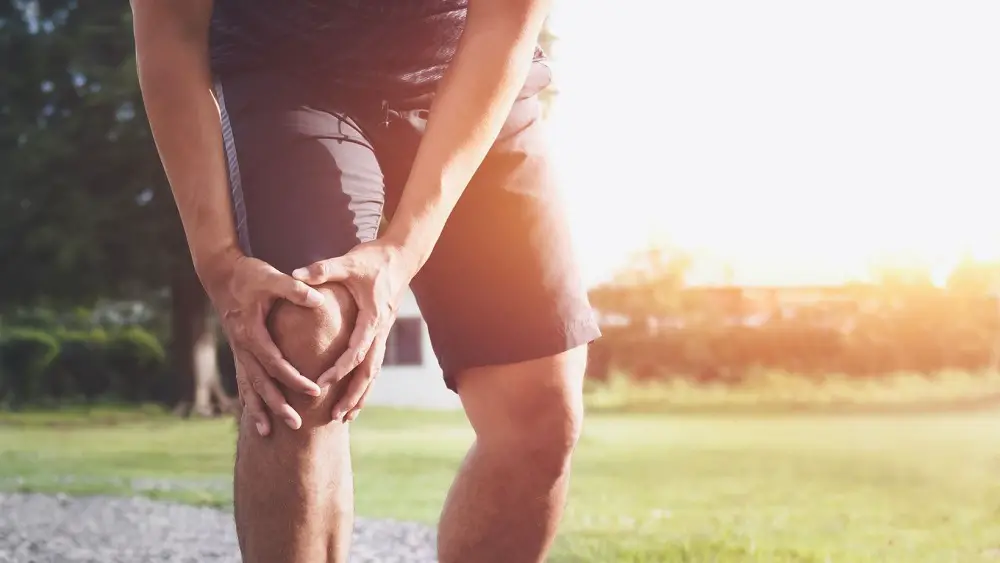Runner’s Knee, which is otherwise referred to by its medical name of patellofemoral pain syndrome, is a very common injury that many runners of all levels typically find themselves experiencing at least once.
Usually caused by the exertion of the muscles around the knee and kneecap area, Runner’s Knee is an injury that needs treatment, otherwise, it can become chronic.

When Runner’s Knee strikes, it commonly starts off slow and gradually becomes worse, with most sufferers reporting mild to severe pain in the knee area.
So, if you’re currently suffering from Runner’s Knee and want to understand it more, rest assured you’ve clicked on the right article. Below, not only are we going to be sharing with you what Runner’s Knee actually is, but we’ll also be providing you with some advice on how to speed up the recovery process.
What Is A Runner’s Knee?
In a nutshell, Runner’s Knee is essentially when a runner or cyclist overexerts their muscles in the knee area.
This can result in a dull but persistent pain in the affected knee and sometimes behind the knee cap, as well as an annoying clicking sound due to bone stiffness.
In addition to that, in some severe instances, sufferers may find themselves struggling to carry out simple, mundane tasks such as stepping in and out of a shower, walking up and down a flight of stairs, as well as walking.
Runner’s Knee Fast Facts
- Despite being most commonly referred to as Runner’s Knee, this injury can also be referred to as patellofemoral pain syndrome, chondromalacia patella, as well as anterior knee pain – although these are far less used.
- Runner’s Knee is extremely common and can affect runners of all levels and abilities.
- On average, it is estimated that Runner’s Knee can affect around 15% of all runners at some point or another.
- If proper treatment is carried out, sufferers can expect to make a full recovery within 6-12 weeks. However, if treatment is not sought, Runner’s Knee can become chronic and potentially irreversible.
What Are The Symptoms Of Runner’s Knee?
As soon as Runner’s Knee strikes, it’s important to make sure that you’re getting it treated as soon as it happens to prevent it from becoming chronic.
As we’re sure you might already be able to guess, the most common symptom of Runner’s Knee is an aching pain specifically around the knee area, although it is typically most common directly behind the back of the kneecap.
More often than not, Runner’s Knee doesn’t usually tend to come on straight away. Instead, runners will usually begin to notice a stiff, dull pain in the knee area during the next day.
However, in some instances, the pain can become so severe that walking or even climbing up a set of stairs can be nearly impossible.
In addition to pain in the knee area when moving, you may also experience a “popping” noise when you move your knee area due to stiffness, and in some instances, there might also even be mild to moderate swelling, as well as bruising.
When you are sitting down or sleeping, you should not experience any pain at all.
How Long Does a Runner’s Knee Last?
If you seek treatment as soon as you notice you have Runner’s Knee, then you can expect to make a full recovery within around 6-12 weeks. However, as we have already mentioned above, if you do not seek treatment then the Runner’s Knee might become a chronic injury.
For this reason, it’s very important that you make sure that you go to your doctor’s so that they can give you proper guidance on how to medically treat your Runner’s Knee.
To give you an idea of what you can expect from the medical treatments, your doctor might recommend you do the following:
Bracing
One of the quickest and simplest ways to treat Runner’s Knee is to use a brace or a similar taping alternative.
Besides helping to reduce any day-to-day pain that you might be experiencing, a brace will help to take a huge portion of pressure off your knee, which will in turn help to prevent the injury from getting worse.
However, it’s very important to keep in mind that braces can’t fix the cause of the injury, which is why they are best-suited to being used in conjunction with other treatments.
Rest
While some people tend to overlook the benefits of rest – it’s one of the most effective ways to help heal Runner’s Knee! By taking a break from running and making sure to give your knee plenty of rest, you will be giving your body time to repair the injury.
Physiotherapy
If you’re suffering from Runner’s Knee, it is highly likely that you’re going to need to undergo physiotherapy.
Widely regarded as being the best treatment for helping to heal a Runner’s Knee, physiotherapy rehabilitation can strengthen the damaged muscles in order to aid in healing and reduce pain.
It’s so effective, in fact, that if you were to undergo it as soon as you begin to notice the symptoms and get diagnosed with Runner’s Knee, you can expect to make a full recovery from anywhere between 6-12 weeks!
Not only that but there has also been plenty of studies that suggest that physiotherapy can, besides aiding in recovery, help to minimize any further aches and pains that are sometimes experienced after the healing process has been completed.
Moreso, if you are recommended by your doctor that you undergo physiotherapy, then you can expect to attend sessions around 4 times a week, with a gradual increase in difficulty as time goes on.
